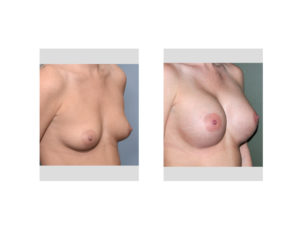The LOOK Method in Breast Augmentation

Most women want natural-looking breasts, with a size and shape that fits their body frame and their chest wall. They would like breasts that, at a glance, looks natural and does not appear surgically enhanced.
By ideal standards, the breast should slope gently downward from the shoulder to the peak of the breast at the nipple. From the nipple to the base of the breast, there is a gentle arc of fullness which creates a teardrop-shaped breast mound. The nipple is located in the middle or just below the middle of the breast mound. From a frontal view, there is some semblance of cleavage as the inner aspects of the breasts drape slightly over the breastbone (sternum). On the sides, the breasts have a rounded curve but do not bulge out beyond the chest wall.
Women seeking breast augmentation generally fall into two categories; those who have never had much breast tissue whose skin is still fairly tight and the nipple is largely centered amidst a small breast mound……and those women who have drooping breasts due to childbearing and nursing or are just a little older and the aging process has had the same effect. The results of the breast augmentation procedure will be different, even if all other factors were the same, for each type of patient.
In the consultation I, most importantly, listen to what bothers the patient about their breasts and what there breast goals are. The most important thing that I point out is……it is not what I can create or want that is important….it is what the patient wants that is important. We are undergoing a breast augmentation operation for the patient….not for me. Then I examine and take measurements of the breasts, particularly noting the width of the natural breast base and looking for any signs of breast asymmetry. I then present the merits of saline vs silicone breast implants as well as different profile options for each implant. The final part of the consultation focuses on desired breast implant size. While there are many ways to make an estimate of what size implant will be needed (e.g., measurements, breast implant sizers), I use what I call the LOOK method. I ask the patient to bring in pictures of what they consider to be a good breast size for them. Then, in the operating room, those pictures are used with intraoperative sizers to choose the final breast implant size based on how they ‘look’. I have found the LOOK method to be the most reliable approach to achieving the size of the breast that the patient wants.
Dr Barry Eppley
Indianapolis, Indiana


